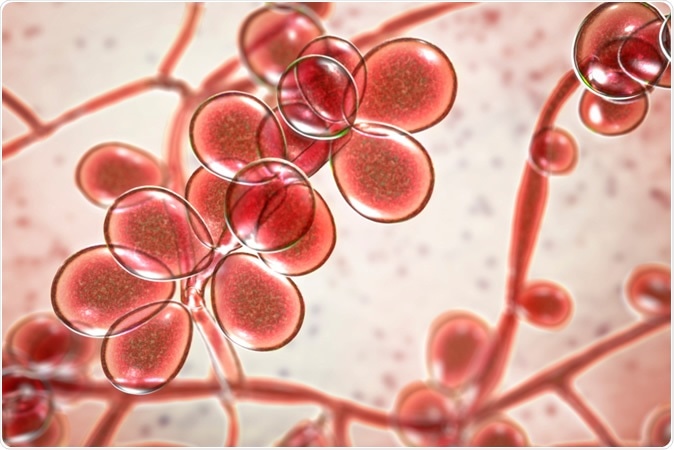There are many fungi that live in the body that make up the normal body microbial flora. One type, Candida, a type of yeast, normally thrives in small amounts in areas such as the skin, abdomen, and mouth, without causing any problem. But, when the body’s environment is altered, the yeast can uncontrollably proliferate and cause disease.
Candidiasis is a fungal infection caused by yeast, with Candida albicans as the predominant cause of the illness. If it develops in the throat or mouth, it is termed as oral thrush or oropharyngeal candidiasis. The infection that develops in the vagina is termed as yeast infection, and if the species enter the bloodstream and affect vital organs, it is called invasive candidiasis.

3D illustration of fungi Candida, the causative agent of candidiasis, thrush, systemic invasive infections. Pathogenic fungus or yeast - Illustration Credit: Kateryna Kon / Shutterstock
Combatting candidiasis infection has been a global health goal. Now, a team of researchers at São Paulo State University's Bioscience Institute (IB-UNESP) in São Vicente, Brazil, found four substances isolated from Mimosa caesalpiniaefolia, are more effective in fighting thrush and candida than fluconazole, a commonly used antifungal medicine.
Published in the Journal of Natural Products, the researchers found two compounds to fight Candida. The plant, Mimosa caesalpiniaefolia, is a shrub native in Brazil. The researchers recommend the compounds be used in formulating an ointment to use as an alternative treatment for candidiasis.
The research study is part of a bigger study, wherein researchers try to look for herbal medicines to treat chronic diseases.
“This discovery and the development of novel therapeutic entities, which in the right combination could lead to a considerable reduction in the necessary concentration of drugs, can minimize the side effects and toxicity of the antimicrobial agents in conventional use," Wagner Vilegas, Full Professor at São Paulo State University's Bioscience Institute (IB-UNESP), said.
"The final cost of treatment can also be reduced, as can the resistance acquired by some microorganisms. More research is needed, including both prospection studies like this one and studies using biological models,” he added.
Potent ointment as an alternative to antifungals
The researchers isolated a total of 23 compounds from the plant, with five new flavonoids, including mimocaesaloin A, B, C, D, and E. When they experimented on the compounds and their effects on two samples of Candida, namely Candida glabrata and C. krusei. Of the 23 compounds isolated from the shrub, four displayed effective antifungal activity than the commonly used drug, fluconazole.
To land to their findings, the team applied the various compounds on the fungal species. Though most had little or no effect at all, four of the 23 displayed promising activity. They are planning to test these compounds as ointments.
“M. caesalpiniifolia extract is very complex. It contains a large amount of chlorophyll and fatty acids, all of which hinder the identification of the compounds present. Thanks to our partnership with colleagues at the University of Cádiz, we were able to separate them and focus our investigation on the most viable fractions," Marcelo José Dias Silva, a postdoctoral fellow at São Paulo State University's Bioscience Institute (IB-UNESP), said.
What are the signs and symptoms of candidiasis?
Candidiasis comes in three forms, the one that affects the mouth and throat, the one that affects the vagina, and the more serious one, which affects vital organs.
In oral thrush, which is more common in newborns, older adults, and those with weakened immune systems, it develops as white and bumpy patches on the tongue gums, throat, inner cheeks, and tonsils. The lesions can be irritating and painful, with the risk of bleeding when scraped. If the infection is worse, it could lead to swallowing problems, and the infection can spread to the esophagus, the passageway of food to the stomach.
In vaginal yeast infection, the yeast spread may cause discharge, intense itchiness of the vagina or vulva, and irritation. Some call the infection as vaginal candidiasis, a condition that affects approximately 3 out of 5 women at some point in their lifetimes.
Source:
Journal reference:
Dias Silva, M., Simonet, A., Silva, N., Dias, A., Vilegas, W., and Macias, F. (2019). Bioassay-Guided Isolation of Fungistatic Compounds from Mimosa caesalpiniifolia Leaves. Journal of Natural Products. https://pubs.acs.org/doi/full/10.1021/acs.jnatprod.8b01025